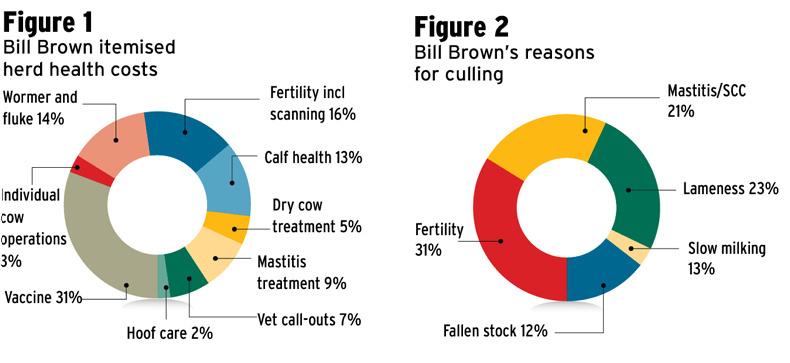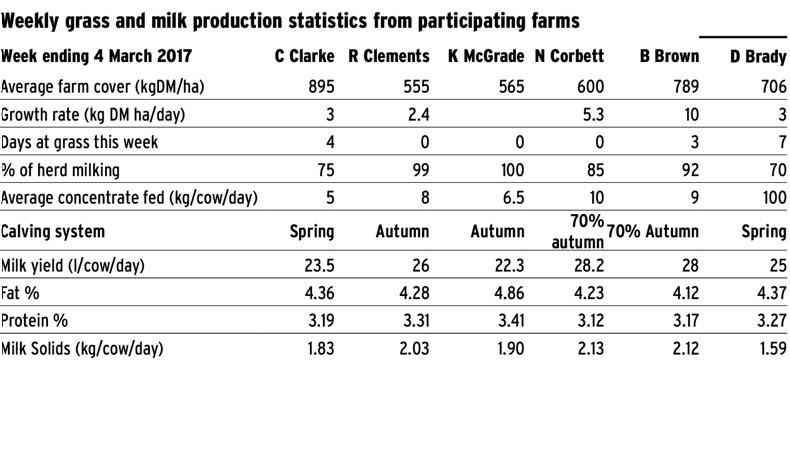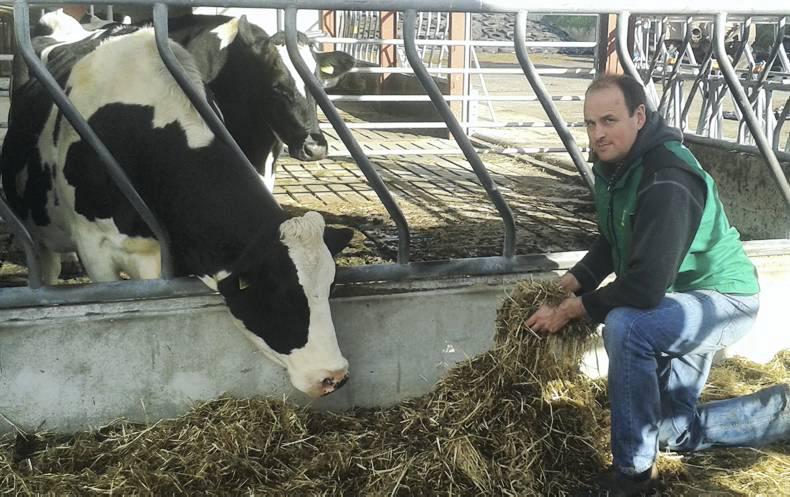Bill Brown incurred a total animal health cost of £18,417 in 2016, which equates to 1.18p/l for the business. This farm is a 100% dairy stock farm with no beef animals. A total of 222 livestock units on the farm leaves the cost per livestock unit at £82/LU.
This cost includes all medicine/ drugs purchased for the herd, veterinary intervention and vet call-out costs on the farm. A percentage breakdown of the total farm health cost is shown in Figure 1.
The preventative vaccine cost is clearly the largest cost on the farm with four vaccines and Rotavec to reduce calf scour going in. This cost also includes a trace element bolus used on the herd which costs £6.50/head.
The next three big costs on the farm are calf health, fertility work and worm and fluke products. The fertility work is carried out by local vet and includes scanning costs. This work is charged as an hourly rate plus products and materials used. A lot of this fertility work is pre-breeding work and inspection of non-cycling cows as identified by Bill. The reality of this work is that cows either get intervention to encourage activity, or they are tagged as potential cull cows no longer able to contribute to the farm. At 16% of the total herd health cost, Bill feels this work is a good investment.
Mastitis treatment takes up 9% of health cost
Calf health care is another major player in the total herd health cost on this farm, and includes all drugs purchased and vet intervention with calves. Pneumonia, calf scour and crypto are the three main problem areas on the farm
Treatment of mastitis in milking cows takes up 9% of the health cost. Cows are treated immediately with lactating antibiotic tube, and with 10% of mastitis cases an antibiotic injection is used.
Dry cow treatment is a long-acting tube plus sealer. The current herd average SCC is less than 100 cells/ml, and the annual herd average SCC is 150. The dry cow treatment cost for last year is artificially low due to a carryover of tubes and sealers from the previous year.
In 2016, 61 cows left the farm, 54 cull cows and seven dead cows. This equated to a culling rate of 29% and a cow mortality rate of 4%. Figure 2 highlights the various reasons for cows leaving the farm with the key reasons for culling cows being infertility followed by lameness and then high-SCC cows.
Urea has been spread on 80 acres of the grazing block; a total of 46 units per acre has been applied. Slurry was spread on outlaying land for silage. I started grazing with 40 cows on 1 February with 65 cows currently in a daytime grazing routine.
Calf rearing slowed down
Out of the 35 possible grazing days since the start of February, we have got 32. The average farm cover is 795kgDM/ha, with the highest cover paddock at 1,600kg DM/ha. Grazing is progressing well but we are struggling to get good clean-out in paddocks with silage and meal still going into these cows at night.
Cows are out after morning milking and separated using the drafting gate each morning. The downside of this is that these cows are in the main milking group during the night with access to a mixed ration. I would like to split these cows into a separate group and restrict access to silage, but this would be difficult to achieve in my cubicle shed. However, I have this group of 60 cows set up on a separate parlour feeding plan, limiting the concentrate going in via the parlour.
Calf rearing has slowed down on the farm with calves now weaned and only still feeding milk to the tail-end of beef-bred calves which will be sold over the next few days. I still have 13 cows to calve on the farm which are due over the next five weeks. Breeding started on 15 December with 150 cows served to date; 72 cows have been scanned in calf as at 1 March.
This week is the end of black-and-white breeding for the herd. Cows bred from now on will be Angus, Belgian Blue or Hereford.
Under the Dairylink project, herd fertility is key and we have culled hard to improve this. Heat detection has also been ramped up with extensive use of the cow heat monitor on the parlour and an AI technician carrying out all cow and heifer inseminations.


Read more
ICBF postpones publishing active bull list
Kerry and Dairygold hold February milk price
Bill Brown incurred a total animal health cost of £18,417 in 2016, which equates to 1.18p/l for the business. This farm is a 100% dairy stock farm with no beef animals. A total of 222 livestock units on the farm leaves the cost per livestock unit at £82/LU.
This cost includes all medicine/ drugs purchased for the herd, veterinary intervention and vet call-out costs on the farm. A percentage breakdown of the total farm health cost is shown in Figure 1.
The preventative vaccine cost is clearly the largest cost on the farm with four vaccines and Rotavec to reduce calf scour going in. This cost also includes a trace element bolus used on the herd which costs £6.50/head.
The next three big costs on the farm are calf health, fertility work and worm and fluke products. The fertility work is carried out by local vet and includes scanning costs. This work is charged as an hourly rate plus products and materials used. A lot of this fertility work is pre-breeding work and inspection of non-cycling cows as identified by Bill. The reality of this work is that cows either get intervention to encourage activity, or they are tagged as potential cull cows no longer able to contribute to the farm. At 16% of the total herd health cost, Bill feels this work is a good investment.
Mastitis treatment takes up 9% of health cost
Calf health care is another major player in the total herd health cost on this farm, and includes all drugs purchased and vet intervention with calves. Pneumonia, calf scour and crypto are the three main problem areas on the farm
Treatment of mastitis in milking cows takes up 9% of the health cost. Cows are treated immediately with lactating antibiotic tube, and with 10% of mastitis cases an antibiotic injection is used.
Dry cow treatment is a long-acting tube plus sealer. The current herd average SCC is less than 100 cells/ml, and the annual herd average SCC is 150. The dry cow treatment cost for last year is artificially low due to a carryover of tubes and sealers from the previous year.
In 2016, 61 cows left the farm, 54 cull cows and seven dead cows. This equated to a culling rate of 29% and a cow mortality rate of 4%. Figure 2 highlights the various reasons for cows leaving the farm with the key reasons for culling cows being infertility followed by lameness and then high-SCC cows.
Urea has been spread on 80 acres of the grazing block; a total of 46 units per acre has been applied. Slurry was spread on outlaying land for silage. I started grazing with 40 cows on 1 February with 65 cows currently in a daytime grazing routine.
Calf rearing slowed down
Out of the 35 possible grazing days since the start of February, we have got 32. The average farm cover is 795kgDM/ha, with the highest cover paddock at 1,600kg DM/ha. Grazing is progressing well but we are struggling to get good clean-out in paddocks with silage and meal still going into these cows at night.
Cows are out after morning milking and separated using the drafting gate each morning. The downside of this is that these cows are in the main milking group during the night with access to a mixed ration. I would like to split these cows into a separate group and restrict access to silage, but this would be difficult to achieve in my cubicle shed. However, I have this group of 60 cows set up on a separate parlour feeding plan, limiting the concentrate going in via the parlour.
Calf rearing has slowed down on the farm with calves now weaned and only still feeding milk to the tail-end of beef-bred calves which will be sold over the next few days. I still have 13 cows to calve on the farm which are due over the next five weeks. Breeding started on 15 December with 150 cows served to date; 72 cows have been scanned in calf as at 1 March.
This week is the end of black-and-white breeding for the herd. Cows bred from now on will be Angus, Belgian Blue or Hereford.
Under the Dairylink project, herd fertility is key and we have culled hard to improve this. Heat detection has also been ramped up with extensive use of the cow heat monitor on the parlour and an AI technician carrying out all cow and heifer inseminations.


Read more
ICBF postpones publishing active bull list
Kerry and Dairygold hold February milk price








 This is a subscriber-only article
This is a subscriber-only article












SHARING OPTIONS: